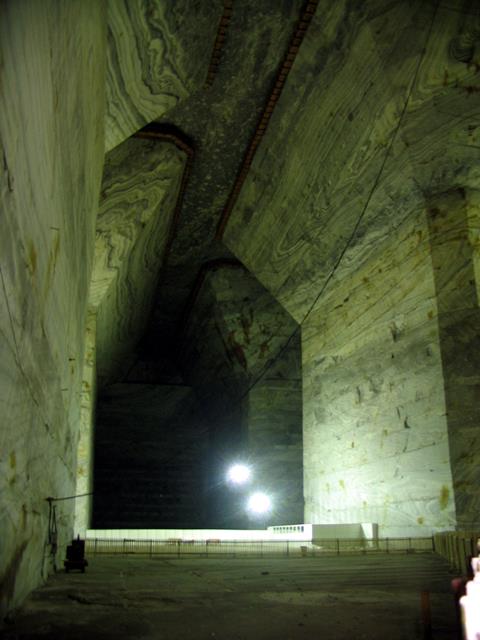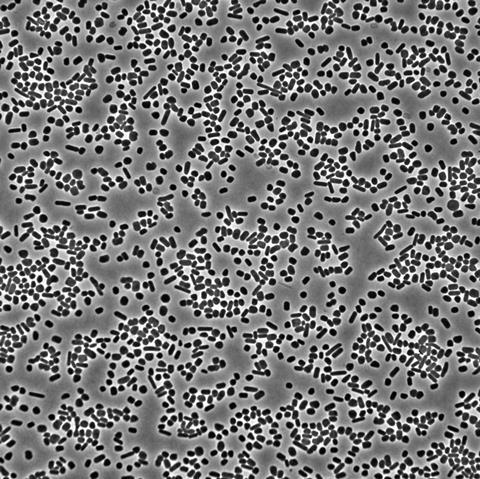Biocatalysis, the use of natural substances such as enzymes to facilitate chemical reactions, has revolutionised the production of many pharmaceuticals and fine chemicals.
The need for extreme industrial biocatalysts
By harnessing the power of microbial enzymes, multiple chemical reaction steps can often be reduced to a single enzymatic step. This has resulted in increased yields, reduced waste, obviation of toxic metal catalysts, greener methods of production, and lucrative returns for those who develop effective biocatalysts.
Despite some impressive achievements in this field, such as the use of transaminase enzymes in the production of the antidiabetic drug sitagliptin, drawbacks remain. Enzymes remain functional only within a limited range of conditions, such as temperature, yet many industrial processes benefit from or even require harsher reaction conditions. Enzymes, particularly those from mesophilic organisms, can become denatured at these extreme conditions. Even those derived from bacteria adapted to more extreme environments are often rendered ineffective in demanding industrial conditions.
Enter the Archaea
The Archaea, that group of microorganisms that form one of the three domains of life, alongside Bacteria and Eukarya, have gained considerable traction in the biocatalytic world in recent years.
Despite increasing interest, archaea remain hugely understudied in comparison to their bacterial counterparts. This may be due to the relative recency of their discovery, first described by Carl Woese in the late 70s. Archaea are considered generally non-pathogenic in humans, a fact which has also served to limit more widespread research attention in this area.
A relative dearth of research has stymied the application of archaeal enzymes in pharmaceutical biocatalysis. This is despite the vast and broadly untapped biotechnological potential of archaeal biocatalysts, which in many cases are capable of tolerating substantially more extreme conditions than bacterial enzymes.
Extremity, rather like beauty, is in the eye of the beholder. Our anthropological view of what constitutes “extreme” may represent a perfectly comfortable living environment for thermophilic archaea, to name but one example. Such is the level of extreme adaptation within the archaea, that entire classification systems have been developed based on the niche in which they are adapted. Archaea can survive all manner of harsh environments, from extremes of pH (acidophiles and alkaliphiles), temperature (thermophiles, hyperthermophiles, and psychrophiles), and salinity (halophiles), to environments of high pressure, radiation, and heavy metal concentrations (piezophiles, radiophiles, and metallophiles, respectively).

The potential of extremophilic archaea in biocatalysis, and biotechnology more broadly, means they are no longer the ignored cousin at the microorganism family party. Archaeal adaptative mechanisms often mean that not only is the cell as a whole adapted to a particular extreme environment, but individual components of their intracellular machinery, such as their enzymes, are adapted too. This makes them uniquely useful for applications in biocatalysis, where harsh reaction conditions dictate the need for robust enzymes.
Archaeal enzymes have the potential to fulfill these roles perfectly. As with the cells in which they reside, these proteins have adapted to function under myriad extreme conditions. From boiling acid to crushing pressures to hypersalinity, the conditions catered for by extreme-adapted archaeal enzymes are broad enough to suit any taste. To paraphrase the crooner Dean Martin (whose views on archaeal extremozymes remain unknown):
“How do you like your extremozymes in the morning?”
“I like a good reaction rate.”
“Boiled or acidified?”
“I’m satisfied, as long as it converts substrate.”
Tenuous puns aside, archaea and their enzymes from a range of extreme conditions have already been investigated for their use in biotechnology. You just need to know where to find them.
Location, location, location
If you want to find a book, you look in a library. If you want to find an archaeal extremozyme that can function at the limits of life, then some of the world’s most inhospitable environments are a good place to start.
Marine hydrothermal vents have been mined, yielding many extremozymes such as hydrolases, from the archaeal order Thermococcales. Archaeal extremozymes, with activity ranges up to 120 °C, from pH 0.1 to 11, and in up to 99% organic solvent, have been found in hot springs right across Europe and the Caucasus. A plethora of extremozymes have been discovered from the genus Sulfolobus, including dehydratases involved in the biocatalytic production of ethanol and isobutanol, isoamylase enzymes for starch processing, and lactonases for bioremediation.
Sulfolobus species have been recovered from acidic solfataric fields such as those found in volcanic regions of Iceland and Italy. It is not surprising that enzymes from these extremophiles often exhibit optimal activity at around 80 °C and pH 2-3. Treasures of the Dead Sea, Red Sea brine pools, and hypersaline lakes include archaeal enzymes tolerant to heavy metals, high salinity, and elevated temperatures, representing huge potential for application in biocatalysis.

Clearly, this field lends itself to interesting fieldwork. Our own quest for archaeal extremozymes has led us to numerous unusual locations, including 300m underground to the depths of a working salt mine, a thalassohaline environment formed during the Triassic period (circa 220-250 mya). Excitedly huddled in a jeep and clad in our overalls, we were treated to an expedition through a 66km network of tunnels to collect brine and halite in search of haloarchaeal transaminase enzymes. More exciting still were the HPLC peaks and colour changes indicating the discovery of novel haloarchaeal enzymes capable of functioning in multi-molar salt concentrations and in the presence of organic solvents.
A work in progress, but progress nonetheless
Archaeal extremozymes undoubtedly possess considerable potential. Their current industrial application, however, is fraught with challenges. Many expression systems for the production of recombinant enzymes are based on bacterial hosts, such as well-established Escherichia coli models. Whilst useful for the production of many archaeal enzymes, very often these hosts are incapable of expressing stable and soluble enzymes, instead producing misfolded or aggregated proteins.
Corrective approaches have had varying degrees of success in refolding archaeal enzymes to their active conformation following expression in bacterial hosts. These include denaturation with chaotropes such as urea followed by refolding or in the case of thermophilic archaeal proteins, expression at ambient temperature followed by refolding at higher temperatures. These approaches can be very involved and often inefficient, and in many cases simply don’t work.
A number of archaeal expression systems have been developed, which have shown promise in circumventing these problems. Sulfolobus species have shown particular potential in this area. Members of this genus are known for their thermoacidophilic tendencies, enabling the production of enzymes stable at high temperatures and at low pH. Their metabolic versatility and genetic systems allow the expression and secretion of thermostable archaeal enzymes that are otherwise challenging to produce in conventional mesophilic systems.
Not only does this genus give us a number of useful systems for heterologous expression, but it is also the source of many useful extremozymes, ensuring its place as one of the major stars of the extremophile biocatalysis world. High-temperature biotechnology has other advantages too, as heat can serve as a selective purification step, as well as reducing microbial contamination
What Sulfolobus species can do with heat and acid, the haloarchaeon Haloferax volcanii attempts with salt. It has been engineered for effective expression of halophilic enzymes, including alcohol dehydrogenases, laccases, proteases and lipases, and transaminases as highlighted above.
Archaeal expression systems represent a viable and exciting approach to unleash the potential of archaeal extremozymes in biocatalytic applications. Innovative research in this area has focused on the development of sustainable and scalable expression systems for large-scale biocatalyst production, as well as creative approaches for enzyme immobilisation and flow biocatalysis.

The golden handcuffs of extreme adaptation
Adaptation to extreme environments, whilst beneficial under extreme selective pressures, can restrict the range within which extremozymes can function, limiting their usefulness in biocatalysis. Not only are these enzymes “extreme-loving”, but they can also often be considered “extreme-dependent”. For example, haloarchaeal enzymes aren’t just able to function at high salinity, they actually require it to maintain their functional conformation. This presents considerable difficulties when trying to use these enzymes in cascades, not only with mesophilic enzymes but even with other extremozymes adapted to different extreme conditions. In the case of halophiles, the high salt concentrations required for high-volume production can also present considerable logistical challenges, such as corrosion-mediated damage to stainless steel bioreactors.
These examples highlight the challenges of successfully expressing archaeal extremozymes and scaling their biotransformations to industrial levels. Not only do the problems not end here, they don’t even begin here! Often difficult to manipulate once identified, ‘good’ archaeal enzymes can also be challenging to find in the first place. As with bacterial enzymes, many initial discoveries have come through culture-based activity-guided approaches. With the advent and subsequent explosion of metagenomic sequencing, this has expanded and evolved to facilitate enzyme discovery using culture-independent approaches. However, given the predominance of bacterial sequences in many databases, sequence-driven metagenomics approaches to enzyme discovery are skewed toward known bacterial sequences.
Function-driven metagenomic approaches, such as those applied in fosmid libraries, could help with this issue and drive the discovery of truly novel archaeal biocatalysts. In this case, random strands of environmental DNA are cloned into plasmids which are used to transform hosts, followed by functional tests, and then sequencing. Again, however, the problem with this approach lies in the lack of developed archaeal library generation and expression systems, which are orders of magnitude less efficient than more well-established bacterial systems.
The relative novelty of archaeal enzyme research compared to bacteria, whilst exciting, means that current drawbacks associated with their application persist. Despite this, new avenues of archaeal research and rapidly advancing technology ensure the potential of archaeal enzyme application in biocatalysis has never been more exciting.

A role for machine learning?
Machine learning is poised to revolutionise the exploration and application of archaeal extremozymes in biocatalysis. Advances like AlphaFold have enabled the accurate prediction of protein structures, including those of extremozymes, offering unprecedented insights into their function and stability under extreme conditions. This foundational knowledge supports rational enzyme design, where archaeal enzymes can be tailored for specific industrial needs, such as improved activity at high temperatures or tolerance to solvents.
Machine learning algorithms can utilise structural and functional data from previously characterised extremozymes as scaffolds for novel biocatalyst design. Training models with datasets containing structural variations, activity profiles, and environmental conditions could enable researchers to easily predict mutations to enhance activity or stability. This capability may be particularly valuable for creating enzymes compatible with mesophilic expression hosts such as E. coli, ensuring industrial scalability without compromising their extreme characteristics.
Rational design towards targeted substrates is another promising avenue, as seen with bacterial enzymes. Machine learning tools can identify and optimise archaeal enzymes to process specific substrates more efficiently, expanding their applicability not only in biocatalysis but also in sectors like biofuel production and bioremediation. By combining high-throughput screening with machine learning-based predictions, the discovery and deployment of archaeal extremozymes in biocatalysis could become faster, cheaper, and more precise, driving sustainable innovation across industries.








No comments yet